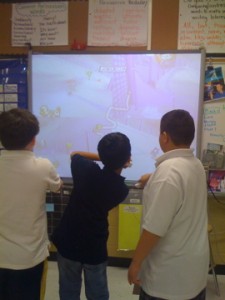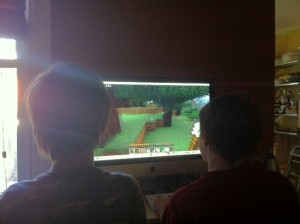 In 2010, I began experimenting with gaming in my classroom.
In 2010, I began experimenting with gaming in my classroom.
In my Grade Six classroom, ‘play’ wasn’t just about learning the facts and materials, but about creating an environment where they were most comfortable. Using Wii Olympics to have students virtually play participate in Luge or skiing events and then write down, sort, compare and analyze their scores helped them see an authentic reason why we sort data. Watching the little JK students exercise for 15 minutes a day using Wii Fit or Wii Sports (on those freezing cold mornings) was fascinating. Using NikeRemote on our shoes, we used game to track distances when we ran 3 times per week to reach our marathon goal. I was only beginning to discover the potential for gaming and learning. Connecting our games with classrooms across the world was the most fun. Skype spelling and math games was an awesome way to end our week. For me it really isn’t about the game itself, but about engaging my students. They identified with gaming. It was my way to capture them, when we couldn’t explore outside, or build ‘hands-on’.
Both Zack and Shawn, future TechEd leaders from Brock University (also students of mine) contemplate educational theories and structures by examining the idea of gamification of learning. In his blog, Zach wonders,
“Imagine if we could give students a lesson they could take home and play? If they enjoyed the lesson they would be more apt to practice the material. They could share it with friends and interact with people in their class online”.
Shawn then makes a profound realization,
“It occurs to me now that my prejudice towards gaming was based on the belief that games were based solely on fun, and so in turn their educational usefulness must be minimal. How silly that was to assume that kids have to feel or even know that they’re being taught in order to learn something”.
Shawn and Zack ‘s posts compelled me to ask my two boys (ages 9 and 11) if they saw any educational value in games (minecraft, wii, kinect) in the classroom or for their own learning. Their answer: No way. It is just for fun.
They have not made the connection between learning and play. I wonder if their definition of “learning” comes from their short experience with an established deep rooted system that still sees learning in a very traditional way. Sitting at a desk, direct instruction, preparing for tests, group activities, writing tests, memorizing facts, studying…
 And yet, on this very Saturday morning, as I read through the blog posts, my eyes wonder. I watch my boys plant crops near water, discussing a location that optimisms sun. I listen to them talk about the best way to ‘make’ paper so they can create books to put on the shelves that they created for the school that they designed. I listen to them talk about the formula needed to make ‘ink’ for their pens…….and then I spy, as they use they internet to find out facts about ink, paper mills and sugar. Then my 9 year old says…lets make a cake. They were using Minecraft.
And yet, on this very Saturday morning, as I read through the blog posts, my eyes wonder. I watch my boys plant crops near water, discussing a location that optimisms sun. I listen to them talk about the best way to ‘make’ paper so they can create books to put on the shelves that they created for the school that they designed. I listen to them talk about the formula needed to make ‘ink’ for their pens…….and then I spy, as they use they internet to find out facts about ink, paper mills and sugar. Then my 9 year old says…lets make a cake. They were using Minecraft.
My eyes wonder to their unopened packpacks. I wonder, what homework they have.
But, as they see it…it is play, not learning. So how do we connect the two? I think that both Shawn and Zack clearly make the point that there may be link between learning and engagement. But, maybe its something more? Do these games also help us with our critical senses? Do they encourage us to talk and problem solve? Do they encourage more divergent ways of thinking?
I certainly do not fully understand the impact that gaming is having on my own children, but by reading about the projects and innovations that a few teachers are ‘action’ researching, my confidence in the use of the methods has definitely heightened.
Joel Levin, a high school teacher discusses his first days of school: – http://minecraftteacher.net/
So, instead, for the first class we’ll talk about:
What kind of world they will want to play in.
What kind of gaming experience they desire and what they’d like to accomplish.
And I’ll try to figure out what other auxiliary projects they want to try while playing the game. Such as writing projects, making Let’s Play videos, modding the game… or who knows! I’m sure they will surprise me!
It is very reassuring that in spite of tradition and set curriculum, teachers are still finding ways to incorporate new mediums into the classroom. Thank you Shawn and Zack for deepening my thinking on this issue.
